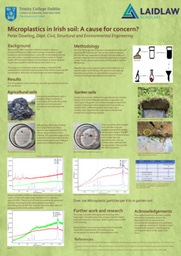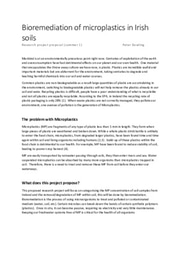Summer 2 LiA
What a summer! My LiA summer project was postponed one year and so coincided with a very busy summer of mine, balancing a college internship, LiA project and other commitments was anything but easy, but I am happy to say it was a success! With real, tangible results that can drive actual change I am proud of my project, and I am excited to share with the Laidlaw Network.
My second summer was spent sampling beaches in the west of Ireland for Microplastics (MPs). The goal of this project was applying the skills and processes I developed in my summer one project, assessing MP concentration in soils, and apply them to a new and topical environment, our coasts. Our beaches are inundated with plastic waste, stroll along any beach in Ireland and you will come across many items of plastic litter. Microplastics are a form of very small (less than 5mm across) pieces of plastic litter. Due to their small size, they are highly mobile and can enter any environment, even the human body, with ease. MP only begun to be studied in the last two decades, with the bulk of papers being written in the last 5 years. As a result, very little is known about effects of MP on the environment and out own bodies. The current literature is quite comprehensive in terms of concentrations and prevalence of MP in a myriad of environment. However, there is a lack of knowledge on the processes and factors that govern MP generation and transport. My LiA project aim was to use engineering principals and my knowledge from my summer one project to determine some of these factors.
I begun by selecting two sites, one in county Galway, one in county Clare, both in the west of Ireland. I chose these sites as they are exposed to the Atlantic, more specifically the gulf stream. The two sites represented different typical beach environments: The Galway beach was sheltered, urban, visited daily by hundreds of people and was regularly cleaned. While in contrast, the beach on Clare’s coast was exposed to the full Atlantic, isolated, frequented by far less people on average and rarely saw any clean-up efforts. An objective of my project was to highlight the global effect of plastic pollution and illustrate that the environmental actions of one country effect the globe.
With sites selected I began sampling. I spent three days of full sampling at each site and concluded with 36 samples of sand from the near and far shores (18 samples per beach, 9 from near shore, 9 from far shore). These samples were then brought to the Atlantic Technological University (ATU), Galway campus where, with the Marine and Freshwater Research Institute (MFRT) processing and further analysis would be done. To contextualise results a throughout sweep of the beach was conducted prior to each sampling session, any large plastic pieces were collected, and the environmental factors of each day were recorded. This was done to provide as much detail on possible MP generation mechanisms as possible.
The results were poignant. Every single sample showed MP contamination, some samples showed as much as 720 MP fragments per kg dry weight. The rural beach showed on average 117% more MP per kg dry weight than the urban beach. The beach sweeps told the same story, more than 1kg of plastic waste was recovered from the rural beach each day over a 100m stretch, compared to less than 100g on the urban beach. (It is worth mentioning that this 100m stretch was the same each day, meaning this small section of strand received more than 1kg of fresh plastic waste in one day!) The exposed beach was subjected to the full force of the Atlantic and its currents which clearly spat out a massive amount of plastic. The plastic collected was catalogued and its origin determined with most of the mass coming from fishing equipment. This type of plastic was directly connected to the MP found in samples taken near the washed-up larger pieces. This suggests that MP breakdown likely occurs in-situ on the beach or in the very near shore area. And, that MP concentrations are directly linked to the beach exposure to larger plastic pieces. It is encouraging in the regard that the removal of large pieces of plastic litter has a direct reduction of MP count. Previously, it was not known if this had any effect, and that the MP present were brought there by another mechanism.
This summer’s research project, and its results and conclusion will soon be available in the form of a scientific journal, as such a short blog post cannot give it justice! Nevertheless, this blog is useful in sharing the work between fellow Laidlaw scholars in an accessible manner. This work was incredible rewarding and highlighted the need for ethical leadership and enthusiasm when tackling environmental problems through engineering.



Please sign in
If you are a registered user on Laidlaw Scholars Network, please sign in